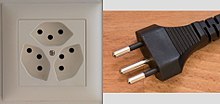The UK does not require different protection and MI's don't normally differentiate between UK or EU and I don't know you keep bleating on about your incorrect guesses about what happens 'over there'.I'm not wrong to ask a question. MI seem to imply the UK requires different protection. I asked why?
The way I read your incessant posts on this subject is a statement that MI's are wrong because things automatically run on 16A OCD's in the rest of Europe.
It is not the case. In many parts of Europe circuits will be designed as radials for a single purpose and the OCD will most likely be chosen for the device running on it. As an example a boiler circuit, whether a 5 or 16A socket or a connexion plate/box or DP switch [yes these are all realistic options], is likely to be fitted with a 3A or 4A MCB.
MODS. Please feel free to remove this if it's inappropriate






